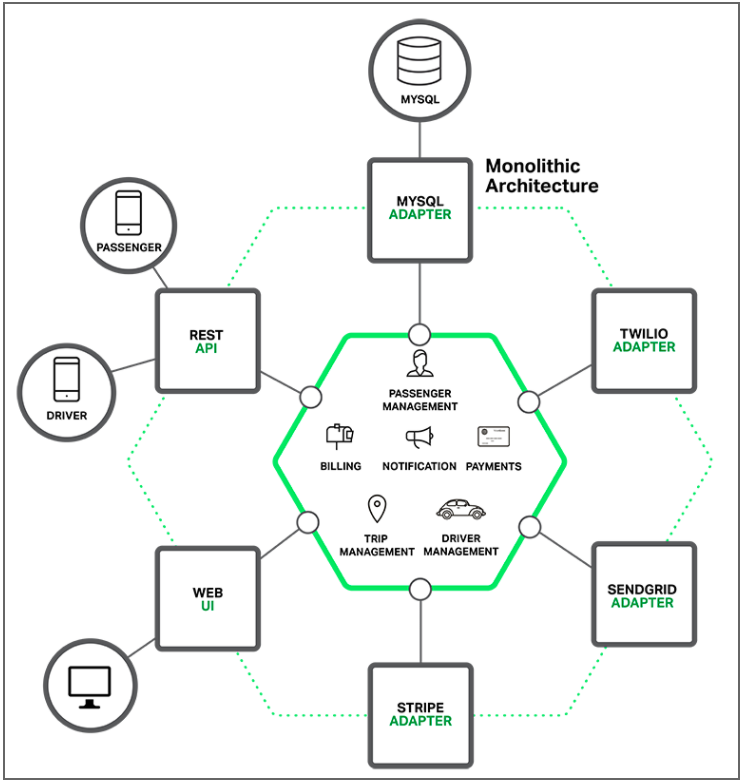What is Micro Services?

About Microservices
Microservices are currently getting a lot of attention. The Microservices Architecture pattern has significant benefits – especially when it comes to enabling the agile development and delivery of complex enterprise applications.
This blog post is the first in a seven-part series about designing, building, and deploying microservices. You will learn about the approach and how it compares to the more traditional Monolithic Architecture pattern. This series will describe the various elements of a microservices architecture. You will learn about the benefits and drawbacks of the Microservices Architecture pattern, whether it makes sense for your project, and how to apply it.
Let’s first look at why you should consider using microservices.
Building Monolithic Applications
Let’s imagine that you were starting to build a brand new taxi-hailing application intended to compete with Uber and Hailo. After some preliminary meetings and requirements gathering, you would create a new project either manually or by using a generator that comes with Rails, Spring Boot, Play, or Maven. This new application would have a modular hexagonal architecture, like in the following diagram:

At the core of the application is the business logic, which is implemented by modules that define services, domain objects, and events. Surrounding the core are adapters that interface with the external world. Examples of adapters include database access components, messaging components that produce and consume messages, and web components that either expose APIs or implement a UI.
Despite having a logically modular architecture, the application is packaged and deployed as a monolith. The actual format depends on the application’s language and framework. For example, many Java applications are packaged as WAR files and deployed on application servers such as Tomcat or Jetty. Other Java applications are packaged as self-contained executable JARs. Similarly, Rails and Node.js applications are packaged as a directory hierarchy.
Applications written in this style are extremely common. They are simple to develop since our IDEs and other tools are focused on building a single application. These kinds of applications are also simple to test. You can implement end-to-end testing by simply launching the application and testing the UI with Selenium. Monolithic applications are also simple to deploy. You just have to copy the packaged application to a server. You can also scale the application by running multiple copies behind a load balancer. In the early stages of the project, it works well.
Marching Towards Monolithic Hell
Unfortunately, this simple approach has a huge limitation. Successful applications have a habit of growing over time and eventually becoming huge. During each sprint, your development team implements a few more stories, which, of course, means adding many lines of code. After a few years, your small, simple application will have grown into a monstrous monolith. To give an extreme example, I recently spoke to a developer who was writing a tool to analyze the dependencies between the thousands of JARs in their multi-million line of code (LOC) application. I’m sure it took the concerted effort of a large number of developers over many years to create such a beast.
Once your application has become a large, complex monolith, your development organization is probably in a world of pain. Any attempts at agile development and delivery will flounder. One major problem is that the application is overwhelmingly complex. It’s simply too large for any single developer to fully understand. As a result, fixing bugs and implementing new features correctly becomes difficult and time-consuming. What’s more, this tends to be a downwards spiral. If the codebase is difficult to understand, then changes won’t be made correctly. You will end up with a monstrous, incomprehensible big ball of mud.
The sheer size of the application will also slow down development. The larger the application, the longer the start-up time is. For example, in a recent survey, some developers reported start-up times as long as 12 minutes. I’ve also heard anecdotes of applications taking as long as 40 minutes to start up. If developers regularly have to restart the application server, then a large part of their day will be spent waiting around and their productivity will suffer.
Another problem with a large, complex monolithic application is that it is an obstacle to continuous deployment. Today, the state of the art for SaaS applications is to push changes into production many times a day. This is extremely difficult to do with a complex monolith since you must redeploy the entire application to update any one part of it. The lengthy start-up times that I mentioned earlier won’t help either. Also, since the impact of a change is usually not very well understood, you likely have to do extensive manual testing. Consequently, continuous deployment is next to impossible to do.
Monolithic applications can also be difficult to scale when different modules have conflicting resource requirements. For example, one module might implement CPU-intensive image processing logic and would ideally be deployed in Amazon EC2 Compute Optimized instances. Another module might be an in-memory database and best suited for EC2 Memory-optimized instances. However, because these modules are deployed together you have to compromise on the choice of hardware.
Another problem with monolithic applications is reliability. Because all modules are running within the same process, a bug in any module, such as a memory leak, can potentially bring down the entire process. Moreover, since all instances of the application are identical, that bug will impact the availability of the entire application.
Last but not least, monolithic applications make it extremely difficult to adopt new frameworks and languages. For example, let’s imagine that you have 2 million lines of code written using the XYZ framework. It would be extremely expensive (in both time and cost) to rewrite the entire application to use the newer ABC framework, even if that framework was considerably better. As a result, there is a huge barrier to adopting new technologies. You are stuck with whatever technology choices you made at the start of the project.
To summarize: you have a successful business-critical application that has grown into a monstrous monolith that very few, if any, developers understand. It is written using obsolete, unproductive technology that makes hiring talented developers difficult. The application is difficult to scale and is unreliable. As a result, agile development and delivery of applications are impossible.
Relevant Blogs:
Recent Comments
No comments
Leave a Comment
We will be happy to hear what you think about this post